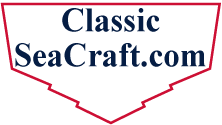
 |
|
#1
|
|||
|
|||
|
I am restoring a 23 footer and have installed a Hermco bracket. I am about to run the steering hoses and controls for the motor. I have seen most Hermco brackets have everything run through the bracket and then to the motor. I don't really understand why this would be preferable over running everything through the transom of the boat.
Drilling into the bracket just introduces another leak path into the bracket which is worse given that the top of the bracket is at the waterline. If running through the transom, the penetration into the hull could be well above the waterline. Please help me understand. thanks |
|
#2
|
|||
|
|||
|
Quote:
Regarding leaks, if you use Don's rigging kit, the aluminum tube that extends through top of swim platform is easy to seal and extends a couple inches above the platform. The plastic rigging tube itself is subject to UV damage and may eventually require replacement, but leaks here are highly unlikely if you keep an eye on the flexible tube. In the unlikely event that the flotation tank should fill with water for whatever reason, a potential leak from the flotation tub into the boat through the transom tube is a more serious issue however, so Don recommends filling the tube with silicone after you've finished rigging it. I was concerned that would make it very difficult to later add anything else to the rigging tube, but I ended up doing that a few years later and found that it actually wasn't that hard to remove the silicone. You'll actually have two holes in the transom filled with silicone, one for rigging tube and one for the steering hoses. As to where to drill the holes, there are two considerations . . . you want them close to the access hatches so it's easy to run the rigging, plus you want to avoid small radius turns between swim platform and motor as it turns and tilts. The 3' long rigging tube pretty well insures you won't have any sharp turns provided you don't locate it too close to the motor. Attached pic shows where I drilled the holes. Motor is partially tilted in picture, but in hindsight, I could have probably moved the rigging tube a little further aft to provide even more room between rigging tube and transom, as it is still off to side of motor far enough to avoid any tight turns or kinks in the tube. The only reason I didn't locate the steering hoses near the port side hatch is that would have required longer hoses, plus there is a stiffing rib inside the bracket tub which prevents running the hoses across the tub to the port side. Stuff mounted on inside of transom (oil tank, fuel filter, trim tab pump) made it too hard to run the steering hoses over to port side inside the boat. One thing I'd do differently on the steering hoses - I used just 2 long hoses, run thru a Cable Clam, from the helm all the way to steering cylinder. Although this minimized connections and potential leak points, those hoses are susceptible to UV damage where they're exposed above swim platform and will eventually require replacement. If I had used some bulkhead-type flare fittings in the swim platform, I could have run one set of hoses from helm to underside of platform, and then another set of short hoses from top of platform to motor. Would have been a bit more expensive and created more connections and leak points but would make future replacement of hoses much easier. In the meantime I covered the exposed hoses with 3/4" plastic wiring loom material to shield them from UV. One other tip regarding brackets . . . I discovered that when you're docking around pilings, the edges of the platform can hit the pilings, so I added some leftover rub rail material to the sides of swim platform (last pic) to add some extra protection!
__________________
'72 SeaFari/150E-Tec/Hermco Bracket, owned since 1975. http://i188.photobucket.com/albums/z...Part2019-1.jpg |
 |
|
|